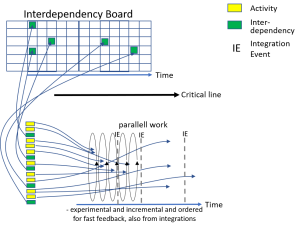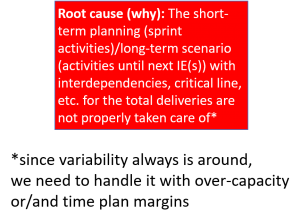From the last two blog posts part 1 and 2 we got the following principle.
Principle: We need to have end to end control* of our activities and their interdependencies, especially them on the critical line, when we are developing our system product and its deliverables, both short-term and long-term and timely updated, as well as on the different levels of our organisation.
If we look into this principle with regards to our evolutionary prerequisites, there are no doubts that we can do it if we look into what we humans already have done; pyramides, Chinese Great Wall, moon flights, etc. that all require great planning**.
The principle look like this:

If we add on the principle in the picture of our principles so far, it will look like this:

And once again, sometimes when a principle is put in a picture, it is easy to also make some light how as well, i.e. in this case visualising the Interdependency Board.
The negated principle, the root causes look like this in our Prefilled Problem Picture Analysis Map.

Now we have finalised “activities with interdependencies” of our start organisation definition and stated our needed principle. But, before we go on with the first part, “People that interact”, it is time for a series of blog posts regarding the Product value flow in the Cynefin™ framework, that I promised some blog posts earlier. C u soon again.
Next “chapter” according to the reading proposal tree is the series of blog posts regarding the “People that interact” part of our start organisation definition for our organisations. For a deep dive for elaborating about queues, see the blog post Elaboration of queues.
*since variability always is around, we need to handle it with over-capacity or/and time plan margins, see this blog post for a deep dive.
**Our planning principle, the WHAT, are supported by many methods and tools, the HOW, like; Kanban boards, Gaant charts, Microsoft Projects, Cost of Delay, Weighted Shortest Job First – WSJF, Critical Path***, Value Stream Mapping, etc., and of course also buffers, margins, underutilization/over-capacity, etc.
***which has been generated transdisciplinary and iteratively with the project team and its sub-teams, common experts, stakeholders, centralised resources etc., i.e. taking also resource constraints for the total organisation into account


It look like the idea is to turn a complex situation into complicated (ref cynefin). What if embracing the complex and adapt to make use of it? Let’s meet and talk more on thursday! Cheers /Johan
Hi Johan, that is a very good comment. When we have uncertainty we need to embrace complexity. And when we know exactly what to do, or can take help from experts to show us the way forward, we instead embrace orderness. But, we need to bear in mind that we humans, have an advantage compared to other living complex adaptive systems, and that is that we can bring order and structure in our organisations to fulfil our needs. We need to embrace that advantage! /Karl